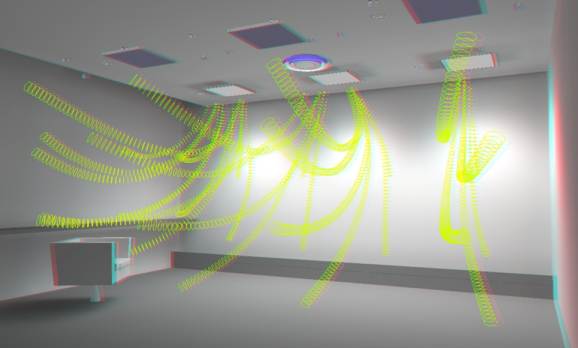3D LIGHT DESCRIPTION
- October 15th, 2011
- Posted in Innovation
- Write comment
For luminaires the description of the light distribution
is essential to characterize a product. For scenes the description of the light field is not considered of such high importance, but as computers enabled us to produce them the awareness might increase.
For viewing the above picture please use red-cyan stereo glasses. The picture itself shows the light field structure of an asymmetrically lit enclosed space. More details on the procedure to generate such 3D representations of the illumination you find in the following presentation.
For viewing the above picture please use red-cyan stereo glasses. The picture itself shows the light field structure of an asymmetrically lit enclosed space. More details on the procedure how to generate such 3D represenations of the illumination you find in the following presentation.
In case you started to ask yourself why do light tubes bend and what can they tell, than continue to read.
What do light tubes tell?
Light tubes represent global characteristics of the illumination field in a scene. The tubes illustrate direction of energy transfer; hence reveal the light fields structures. Each light tube gives information about light flux, the intensity of light on a point and the direction of light for that point in space. There is no direct information about light density contained. A perfectly diffuse lit space with equal amounts of light coming from all directions will show no net flux transfer, hence the light vector is 0 and there is no flux line and respectively no light tube.
The information about lights directionality can indicate how lively a scene will be perceived. A varied structure is likely to be more vigorous perceived as a basal structure. The representation through tubes can exemplify the structure rather well as light arriving at points in space varies smoothly from place to place (except at defined boundaries as surfaces or shadows).
Characteristics of light tubes are best explained with an example. In the following three movies are three light situations characterized by simple descriptions of the light field with six tubes only.
1. Room illuminated by a single centrally located light source.
2. Room asymmetrically lit by three diffuse light sources.
3. Room lit by applying wall washing illumination along two walls.
Why do light tubes bend?
For the understanding of flux lines it is important to distinguish them from light rays. Light rays can and do cross each other, flux lines cannot. The illumination in a room can be described by an infinite number of flux lines. For each flux line the direction coincides at every point with the direction of the illumination vector at that point. Through each point only a single flux line can pass. At places with an illumination vector of 0 there is no flux line. To represent the light field it is convenient to replace the infinite number of flow-lines by a finite number of tubes of flux, the sides of which are formed by flux-lines. Generally flux tubes start from light sources and proceed through space until a surface is reached. The shape of the tubes is determined by the light vector at points in space and as the light vector directions are changing from point to point tubes show curvature.
cite page as: http://info.lightingresearch.eu/flow/
